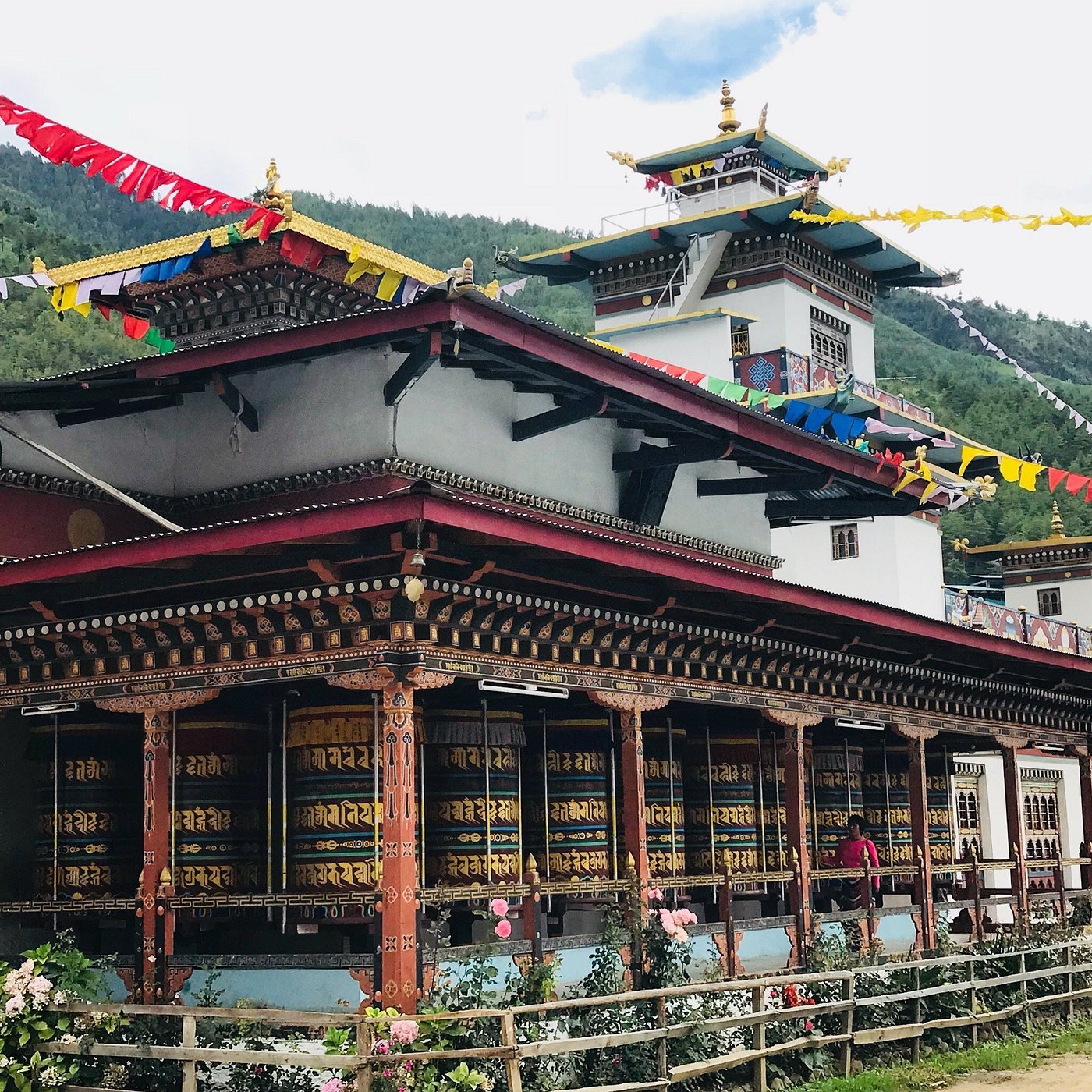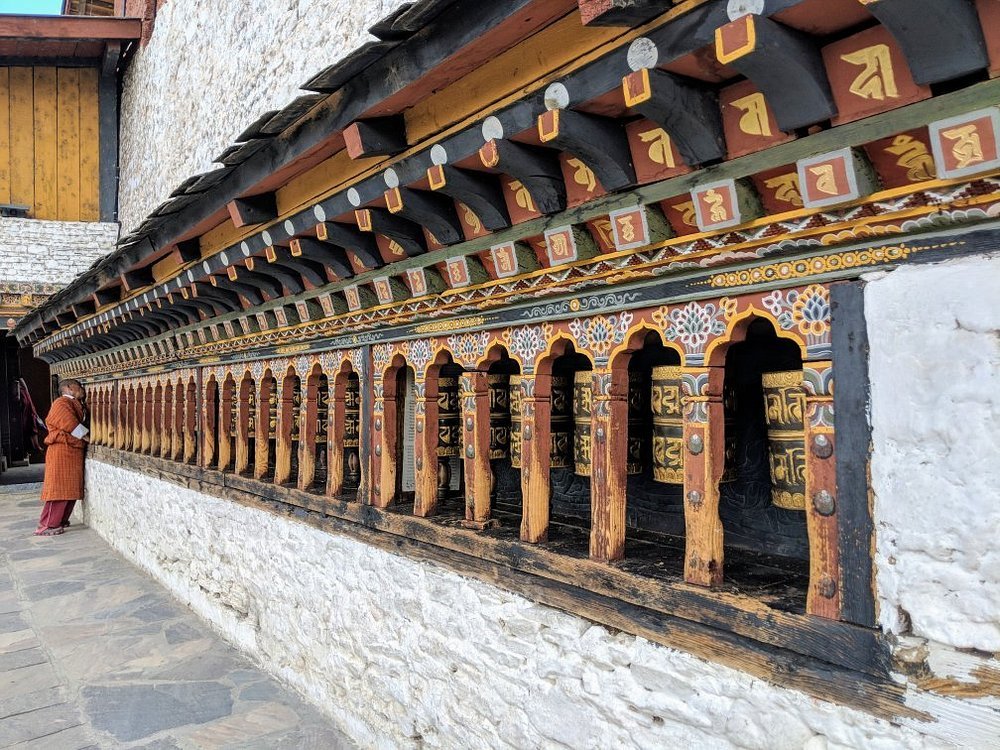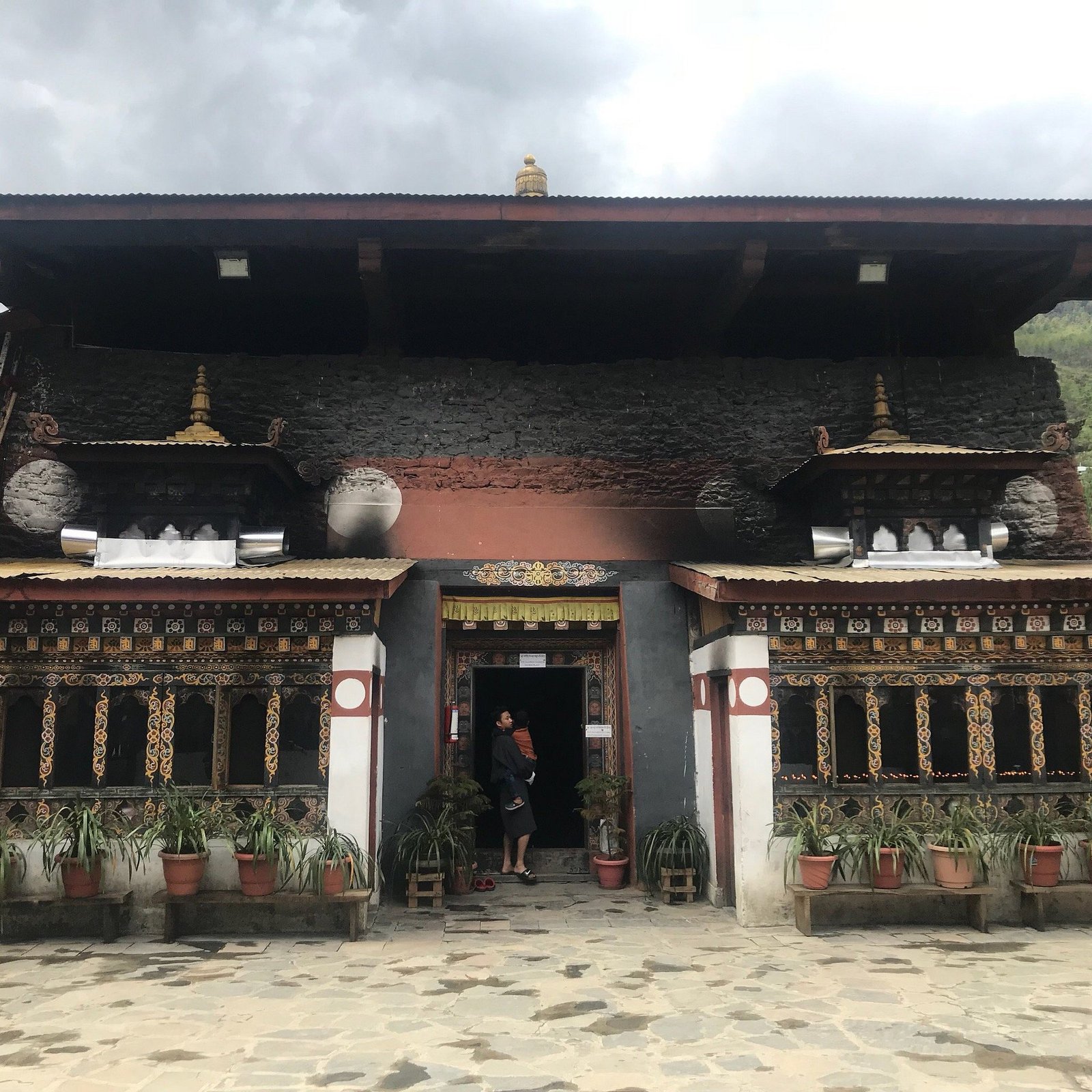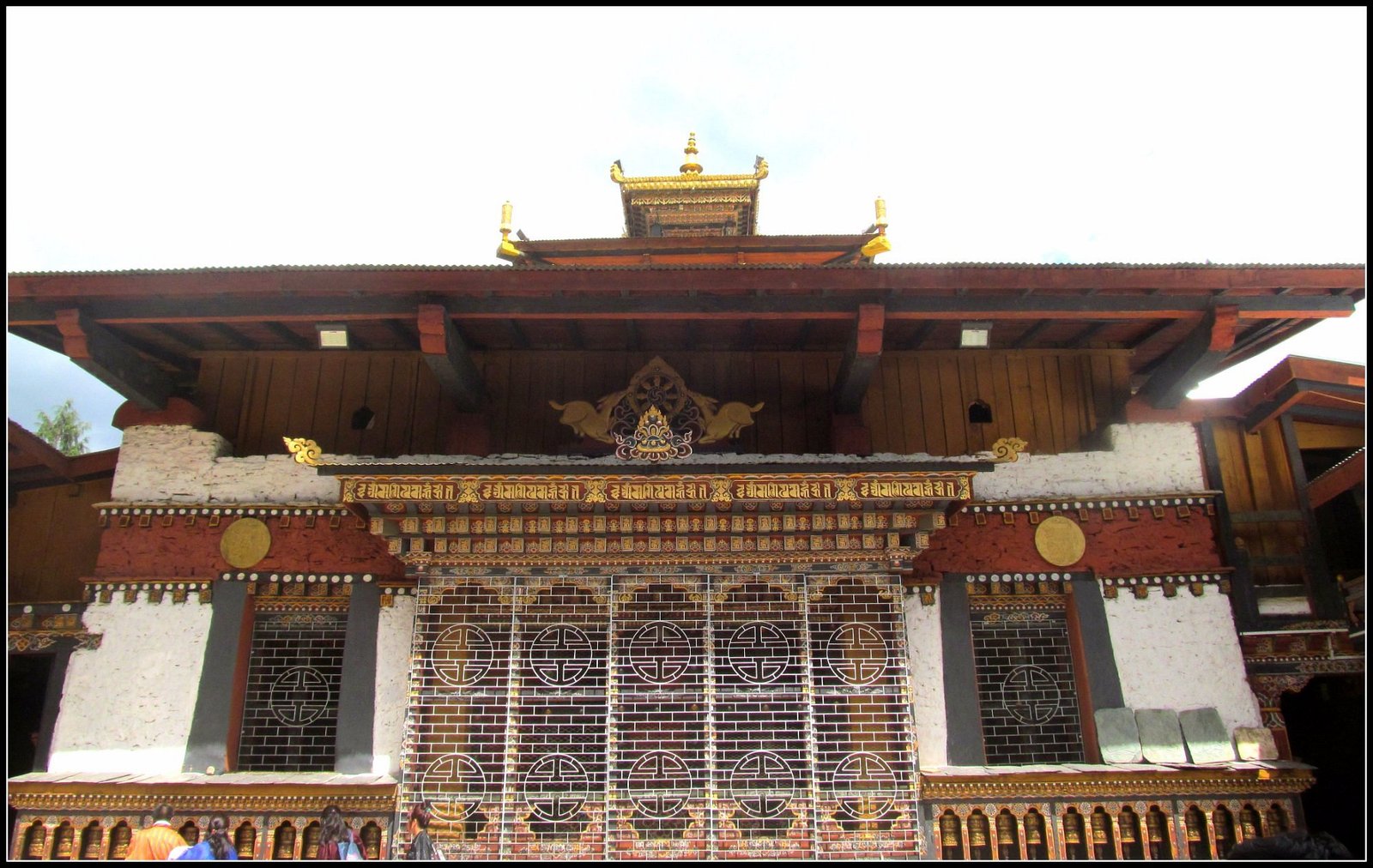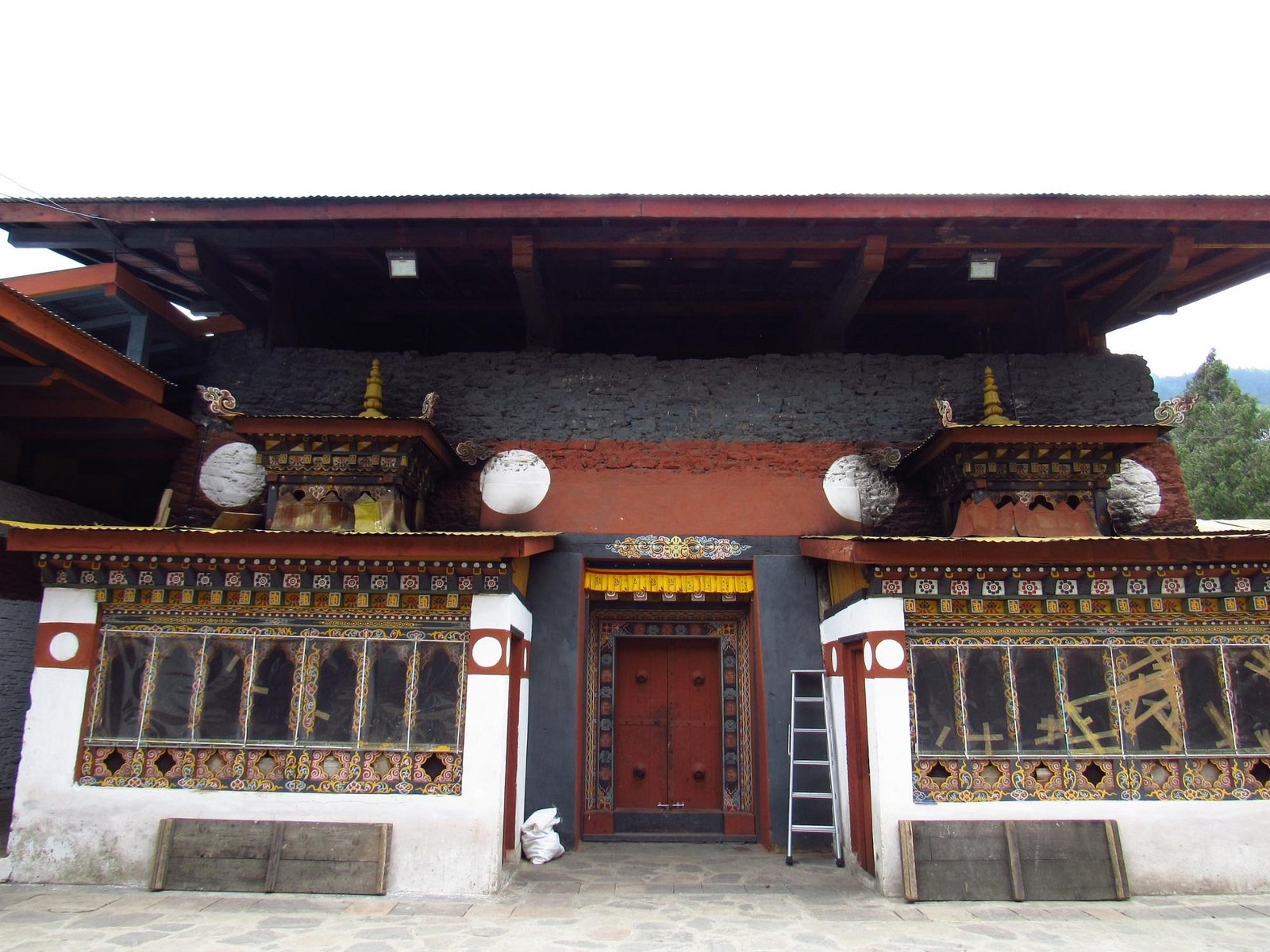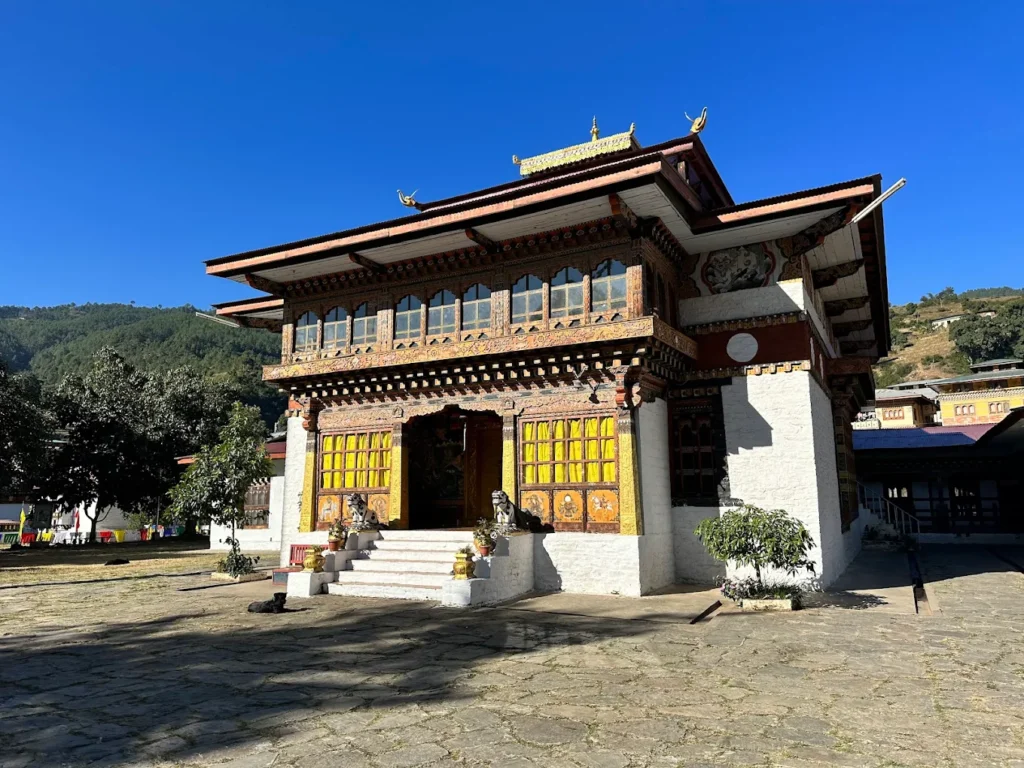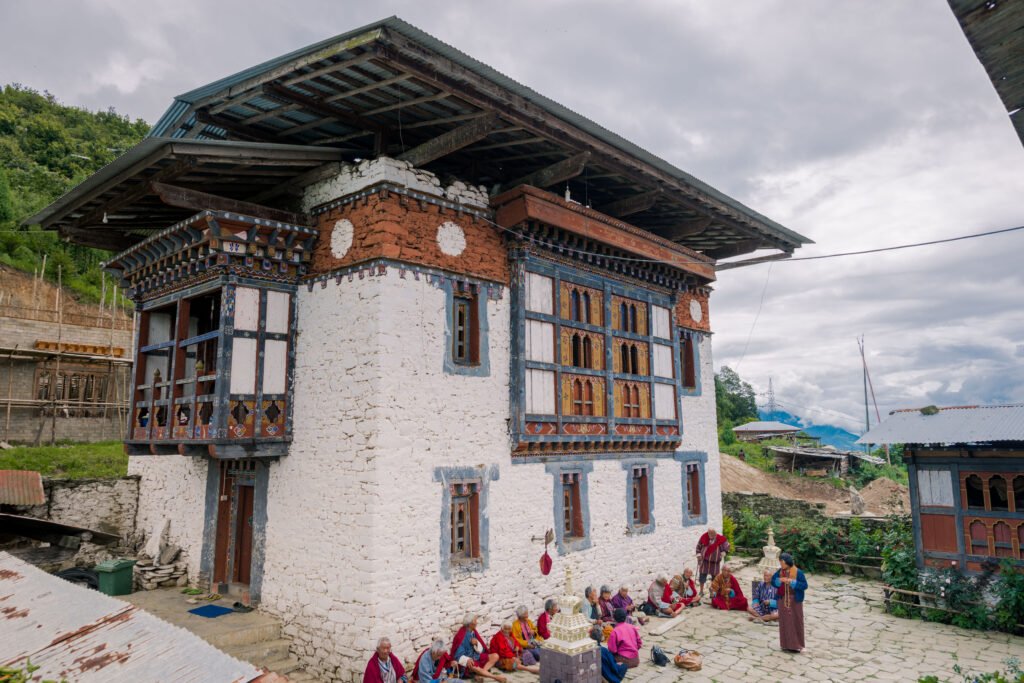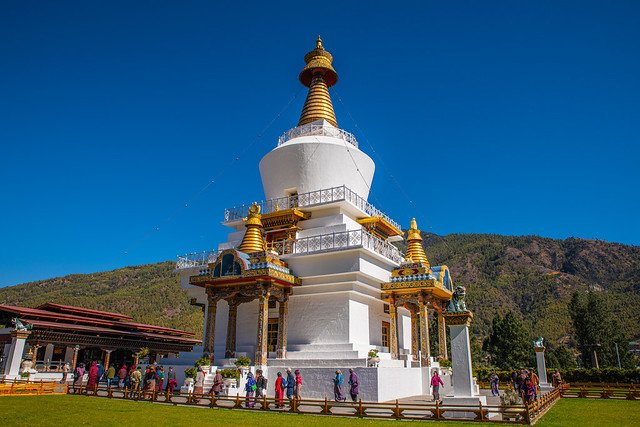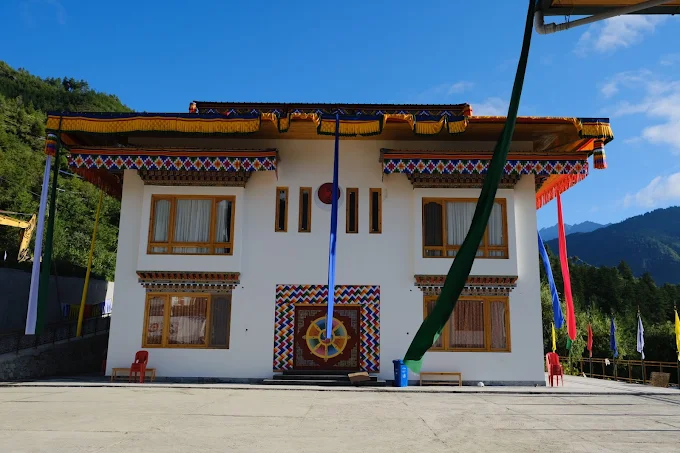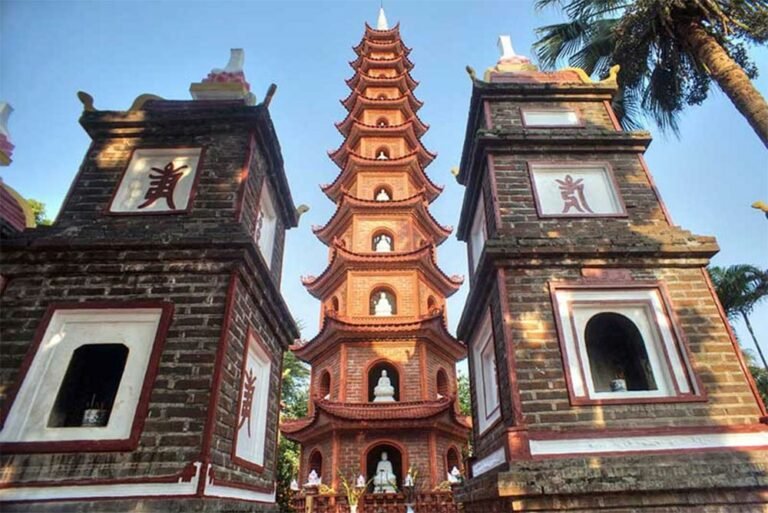Changangkha Lhakhang: The Sacred Hilltop of Thimphu’s Drukpa Kagyu Blessings
Perched majestically atop a hill overlooking Thimphu’s bustling valley, where the morning mist weaves through a grove of cypress and pine, Changangkha Lhakhang stands as a beacon of spiritual serenity, its stone walls aglow with the first rays of dawn. Within the sacred main temple (lhakhang), families offer soft prayers before a towering bronze statue of Chenrezig, the eleven-headed embodiment of compassion, as monks chant the Om Mani Padme Hum mantra to bless newborn children. Founded in the 12th century by Lama Phajo Drugom Zhigpo, this Drukpa Kagyu sanctuary holds a cherished tradition of safeguarding the valley’s youngest souls, its prayer flags fluttering like whispers of hope. The air carries the fragrance of sandalwood incense, each stick lit to honor the protective deities, while the panoramic view of Thimphu Dzongkhag below ties the lhakhang to Bhutan’s spiritual heart. This hallowed retreat invites travelers, seekers, and scholars to ascend its slopes and partake in the blessings of Drukpa Kagyu devotion.
Whispers of Protection: Overview and Significance
Introduction to Changangkha Lhakhang
Changangkha Lhakhang, elevated on a hilltop in central Thimphu Dzongkhag, Bhutan, is a revered Drukpa Kagyu sanctuary, celebrated for its sacred role in blessing newborns and its commanding view over the valley. A short climb from Thimphu’s northern edge reveals a tranquil haven where the rustle of cypress and distant city hum create an atmosphere of peace. Named “Changangkha” for its historic hill, it embodies Bhutan’s spiritual heritage, blending meditation with the protective rites for the young. A cultural and spiritual jewel, the lhakhang weaves history, blessing, and Himalayan reverence into a timeless refuge.
Historical Journey
Changangkha Lhakhang was founded in the 12th century by Lama Phajo Drugom Zhigpo, a pivotal figure in spreading Drukpa Kagyu teachings, who chose its hilltop for its auspicious energy. By the 15th century, it emerged as a center for blessing newborns, its stone walls expanded under local patronage. Strengthened in the 17th century during Zhabdrung Ngawang Namgyal’s era, the lhakhang withstood time’s trials, its structure enduring through Bhutan’s history. Recent community efforts have preserved its sanctity, maintaining its role as a pilgrimage and ceremonial site.
Cultural Significance
- Drukpa Kagyu Devotion: Rooted in the Drukpa Kagyu lineage, the lhakhang venerates Chenrezig and Guru Rinpoche, emphasizing compassion and protection.
- Bhutanese Heritage: A spiritual anchor for the Bhutanese, it preserves rituals like newborn blessings and mantra recitation, reflecting national identity.
- Protective Legacy: Its tradition of safeguarding infants shapes family and community life.
- Regional Influence: Pilgrimages draw devotees from Thimphu and surrounding areas, fostering unity.
Unique Legacy
- Newborn Blessings: The lhakhang’s role in protecting infants is a cherished Drukpa Kagyu custom.
- Hilltop Serenity: Its elevated perch enhances meditative focus, distinct among Thimphu’s lhakhangs.
- Historical Endurance: Founded in the 12th century, it reflects Bhutanese resilience.
- Cultural Symbol: Its protective rites mirror Bhutan’s spiritual compassion.
Community and Global Impact
- Local Devotion: The lhakhang hosts blessings and festivals, strengthening Bhutanese Buddhist ties.
- Pilgrimage Hub: Thousands visit annually, drawn by its infant blessing tradition and scenic view.
- Global Appeal: International families and meditators seek its protective rituals.
- Cultural Dialogue: Shared ceremonies unite Bhutanese and global visitors, fostering understanding.
Modern Relevance
- Spiritual Retreat: Changangkha offers solace for mindfulness in a modern world.
- Cultural Preservation: It safeguards Drukpa Kagyu practices, ensuring Bhutan’s heritage thrives.
- Community Role: Its blessings continue to nurture Thimphu’s families.
Historical Anecdotes
- Phajo’s Founding: His 12th-century vision established its protective sanctity.
- Zhabdrung’s Support: 17th-century patronage enhanced its role.
- Blessing Tales: Stories of infant miracles fuel its reputation.
Social Role
- Community Hub: Blessings and festivals unite Thimphu’s Buddhists.
- Educational Center: Monks guide families in protective rites.
- Charitable Spirit: Communal feasts reflect Drukpa Kagyu’s compassion.
Artistic Influence
- Thangka Art: Murals of Chenrezig inspire Bhutanese artists.
- Cultural Icon: The lhakhang’s hilltop view graces local imagery.
- Festival Art: Cham dance masks showcase Bhutanese craftsmanship.
Changangkha Lhakhang’s hilltop perch, where Phajo Drugom Zhigpo once meditated, weaves a narrative of devotion and protection that defines Bhutan’s Drukpa Kagyu legacy. From its 12th-century founding to its enduring role as a sanctuary for newborns, the lhakhang’s history pulses with the compassion of Chenrezig, uniting monks and families in pursuit of blessings. Its sacred halls and scenic trails set the stage for an architectural tapestry that mirrors its Himalayan soul. As we delve into its physical and spiritual features, Changangkha’s design reveals how its elevated beauty nurtures profound faith and community care.
Crafted by the Hill: Architectural and Spiritual Features
Iconic Design
Changangkha Lhakhang’s architecture blends Bhutanese Drukpa Kagyu elegance with its hilltop setting, creating a sanctuary that harmonizes with Thimphu’s rugged landscape. Whitewashed stone walls and wooden roofs, adorned with prayer flags, rise from the 2,600-meter elevation, reflecting Buddhist serenity. The compact layout, centered on the main lhakhang, prioritizes meditative and ceremonial function, with courtyards fostering community. Its perch above Thimphu Dzongkhag, overlooking the valley, amplifies its sacred resonance, tying the lhakhang to Bhutan’s Himalayan ethos.
Key Structures
- Main Lhakhang: The spiritual core, housing Chenrezig’s statue, built in the 12th century.
- Chorten Courtyard: Stone stupas honor past lamas, surrounded by prayer wheels.
- Meditation Chambers: Small rooms for monks, carved into the hill.
- Prayer Flag Poles: Tall structures strung with flags, dotting the hillside.
- Guest Pavilion: A modest space for pilgrims, blending with the terrain.
- Bell Tower: A small structure with a bronze bell, rung during ceremonies.
Worshipped Statues
- Chenrezig (Avalokitesvara): A bronze statue with eleven heads, symbolizing compassion, radiates protection.
- Guru Rinpoche (Padmasambhava): A gilt statue, embodying spiritual guidance, stands prominently.
- Manjushri: A white stone statue, representing wisdom, flanks the altar.
- Spiritual Role: Families offer butter lamps to Chenrezig, seeking blessings for newborns.
Materials and Techniques
- Construction: Local stone and timber, joined with Bhutanese techniques, ensure durability.
- Artistry: Thangka murals and wooden carvings, crafted by Thimphu artisans, reflect Drukpa Kagyu symbolism.
- Cultural Essence: The design prioritizes protective and meditative simplicity.
Signature Elements
- Chenrezig Statue: The eleven-headed figure anchors the lhakhang’s blessing tradition.
- Chorten Cluster: Stupas symbolize spiritual protection, a unique feature.
- Prayer Flags: Fluttering flags carry blessings over the valley.
Lesser-Known Features
- Ancient Thangkas: Faded murals depict Chenrezig’s forms in the lhakhang.
- Hidden Relic: A small prayer bead, linked to Phajo’s era.
- Old Prayer Wheel: A weathered mani wheel, spun since the 15th century.
Preservation Efforts
- Restoration (17th century): Expanded with community effort, preserving original design.
- Challenges: Monsoon erosion affects stonework, requiring care.
- Modern Additions: Solar lights enhance evening accessibility.
Environmental Integration
- Hill Harmony: The lhakhang’s design respects Thimphu’s forest ecosystem.
- Eco-Practices: Monks maintain trails and protect local flora.
- Wildlife Haven: Birds nest nearby, enhancing serenity.
Artisan Narratives
- Mural Painters: Thimphu artists restored thangkas, preserving art.
- Stone Masons: Local craftsmen rebuilt walls, blending tradition.
- Flag Weavers: Nuns crafted prayer flags, embedding blessings.
Symbolic Details
- Prayer Flags: Five colors balance elements, spreading dharma.
- Chortens: Represent the Buddha’s mind, guiding blessings.
- Thangkas: Depict protection’s path, inspiring faith.
Landscape Integration
- Hilltop Perch: Enhances meditative and protective focus.
- Valley Views: Thimphu’s expanse mirrors inner calm.
- Cypress Groves: Provide solitude and spiritual resonance.
Changangkha Lhakhang’s stone lhakhangs and sacred courtyards, perched above Thimphu’s valley, are more than architectural marvels; they are sanctuaries for the Drukpa Kagyu practices that define its protective soul. The statue of Chenrezig, illuminated by butter lamps, anchors rituals that connect families to Bhutan’s spiritual lineage. These hallowed spaces, alive with chants and blessings, invite visitors to engage with the lhakhang’s living traditions. As we explore its rituals, Changangkha’s role as a meditative and communal retreat comes to life, guiding devotees toward compassion and safety.
Rites of the Blessed: Rituals and Practices
Daily Sacred Rites
- Morning Chanting: Monks recite the Om Mani Padme Hum mantra at dawn, fostering compassion.
- Meditation Sessions: Silent meditation, held twice daily, centers on Mahamudra practices.
- Butter Lamp Offerings: Families light lamps before Chenrezig, praying for newborn protection.
Unique Practices
- Newborn Blessings: Parents bring infants for Chenrezig’s blessings, a Drukpa Kagyu tradition.
- Protective Puja: Rituals honor local deities, seeking safety for the valley.
- Signature Ritual: Tying prayer flags for newborns, tied to the lhakhang’s protective role.
Festival Traditions
- Changangkha Tshechu (10th day, 5th lunar month): Cham dances and Chenrezig offerings draw pilgrims.
- Lhabab Duchen: Ceremonies honor the Buddha’s descent, with chorten circuits.
- Losar (Bhutanese New Year): Monks perform purification rites, blessing families.
- Statue Veneration: Chenrezig’s statue is adorned with silk during festivals.
Visitor Engagement
- Accessible Rituals: Visitors can join chants or observe blessings, guided by monks.
- Offerings: Butter lamps and prayer flags, available at the lhakhang, invite participation.
- Drukpa Etiquette: Bow before statues and maintain silence during ceremonies.
Spiritual Community Roles
- Monastics: Over 20 monks lead rituals and guide blessings.
- Lamas: Senior monks perform infant consecrations.
- Lay Devotees: Thimphu families maintain grounds and offer supplies.
Interfaith Connections
- Syncretic Practices: Some blend Buddhist rites with Bon offerings, honoring local spirits.
- Outreach: Festivals welcome diverse faiths, fostering unity.
- Education: Monks share blessing traditions with visitors.
Ritual Symbolism
- Butter Lamps: Represent wisdom protecting innocence.
- Prayer Flags: Symbolize blessings for newborns’ futures.
- Cham Dances: Enact spiritual safeguarding over the community.
Seasonal Variations
- Spring Rites: Vibrant with cypress, ideal for Changangkha Tshechu.
- Winter Blessings: Cold enhances family gathering focus.
- Monsoon Chants: Rain amplifies mantra resonance.
Monastic Life
- Daily Routine: Monks rise at 5:00 AM for chants, meditation, and blessings.
- Community Service: Monks guide families and maintain lhakhangs.
- Training Hub: Monks learn protective rites, supporting Thimphu’s faith.
Changangkha Lhakhang’s rituals, from the Om Mani Padme Hum mantra to newborn blessings, breathe life into its hilltop sanctuary, connecting families to the Drukpa Kagyu lineage. The lhakhang’s protective practices, rooted in Bhutan’s spiritual faith, invite visitors to engage with its communal heart, whether through chants or silent reflection. For travelers, these rites offer a glimpse into Thimphu’s sacred traditions, accessible within its elevated grounds. As we turn to visitor information, Changangkha’s hilltop setting guides practical planning, ensuring a meaningful journey to this blessed retreat.
Journey to the Heights: Visitor Information
Navigating to Changangkha Lhakhang
- Location: Central Thimphu Dzongkhag, 2,600 meters, 2 km from Thimphu center, near Changangkha Hill.
- Landmarks: Near the Bhutan Telecom Tower and Zilukha Nunnery, with clear Dzongkha and English signs.
- Routes: Walk or drive from Thimphu’s northern road, a short climb from the base.
Address of Changangkha Lhakhang
- Dzongkha: Changangkha Lhakhang, Thimphu Dzongkhag, Bhutan.
- English: Changangkha Lhakhang, Thimphu District, Bhutan.
Visiting Hours and Etiquette
- Hours: Open daily, 6:00 AM–6:00 PM, with blessings available mornings.
- Etiquette: Dress modestly, remove shoes before lhakhangs, and avoid disturbing rituals.
- Drukpa Custom: Offer butter lamps with both hands and bow to statues.
Transport Options
- By Foot: A 15-minute walk from Thimphu’s northern edge up the hill.
- By Taxi: Drive to the base, then walk the short incline.
- By Bicycle: A scenic ride suits active visitors.
Accessibility and Safety
- Mobility: Steep steps may challenge those with mobility issues; flat areas are accessible.
- Safety: Well-maintained paths and monastic presence ensure security.
- Tips: Wear sturdy shoes for the climb and bring water.
Amenities and Surroundings
- Facilities: Restrooms and a small prayer area offer basic amenities.
- Nearby: Tashichho Dzong and National Memorial Chorten, within 3 km, offer cultural experiences.
- Dining: Vegetarian meals at Thimphu’s eateries, like Bhutanese Traditional Restaurant, nearby.
Immersive Visitor Tips
- Best Timing: Early morning visits offer serene chants and cooler weather.
- Sensory Moments: Inhale cypress-scented air and hear mantra recitations.
- Statue Connection: Offer butter lamps to Chenrezig and reflect briefly.
- Festival Planning: Attend Changangkha Tshechu for cham dances.
Nearby Cultural Experiences
- Tashichho Dzong: Thimphu’s fortress, 2 km away, blends history and spirituality.
- National Memorial Chorten: A sacred stupa, 3 km away, honors the third king.
- Dechen Phodrang Monastery: A training hub, 4 km away, offers monastic insight.
Photography Tips
- Best Angles: Capture Chenrezig’s statue at sunrise for golden light.
- Respectful Shots: Avoid photographing blessings without permission.
- Scenic Views: The valley offers stunning Thimphu panoramas.
- Equipment: A smartphone or lightweight camera suffices.
The ascent to Changangkha Lhakhang, guided by Thimphu’s hilltop trails, is a pilgrimage that blends spiritual discovery with communal connection, inviting visitors to engage with its Drukpa Kagyu traditions. The lhakhang’s halls and courtyards, vibrant with chants and newborn blessings, offer a window into Bhutan’s sacred heart, where compassion feels tangible. Beyond its elevated serenity, Changangkha’s deeper cultural and spiritual significance enriches the experience, revealing the essence of Himalayan Buddhism. As we explore these insights, the lhakhang’s role as a beacon of protection and faith comes into sharper focus, deepening our connection to its sacred legacy.
Insights of the Blessed: Cultural and Spiritual Reflections
Drukpa Kagyu Philosophy
Changangkha Lhakhang embodies Drukpa Kagyu’s core: compassion and wisdom through meditation and protection. Chenrezig and Guru Rinpoche inspire devotees to nurture innocence, reflected in newborn blessings and chants. Mahamudra teachings emphasize direct realization, guiding monks toward enlightenment.
Environmental Spirituality
The lhakhang’s hilltop perch ties it to Himalayan reverence for nature. The valley’s cypress and distant city hum foster meditative calm, with offerings honoring local deities. The landscape invites reflection on harmony with the natural world.
Artistic Symbolism
Thangka murals depict Chenrezig’s compassion, symbolizing protective triumph. Chortens represent the Buddha’s mind, while prayer flags balance elements. These elements weave Drukpa Kagyu ideals into the lhakhang’s aesthetic.
Community Resilience
Founded by Phajo’s devotees, Changangkha reflects Bhutanese perseverance through time. Its blessing role showcases collective faith, sustained by volunteer-led efforts, uniting Thimphu’s families.
Environmental Stewardship
The lhakhang’s slopes foster Buddhist environmental ethics. Monks protect trails and local flora, ensuring balance. Visitors are urged to honor the hill’s sanctity.
Meditative Practices
Drukpa Kagyu meditation, including Mahamudra, cultivates awareness. The lhakhang offers spaces for blessing retreats, guided by monks, amplifying inner peace amidst Thimphu’s heights.
Cultural Narratives
- Phajo’s Legacy: Tales of his 12th-century founding inspire devotion.
- Blessing Stories: Families share infant miracle tales, linking past and present.
- Festival Lore: Changangkha Tshechu dances carry ancient traditions.
Historical Context
- Early Foundations: Phajo’s work shaped Bhutan’s Buddhist identity.
- Zhabdrung’s Era: 17th-century support strengthened Changangkha’s role.
- Modern Continuity: Its blessing tradition endures in Thimphu’s culture.
Reflecting on the Journey
Changangkha Lhakhang, cradled on Thimphu’s sacred hilltop, is a sanctuary where protection meets compassion. Its lhakhangs and courtyards, alive with Chenrezig’s legacy, embody Bhutan’s Drukpa Kagyu soul, inviting all to seek blessings. The lhakhang’s trails, worn by centuries of families, tell a story of resilience and devotion, rooted in Himalayan faith. Whether meditating before Guru Rinpoche, witnessing newborn rites, or tracing Bhutan’s protective heritage, visitors find a space to reflect and connect. As you descend, the cypress scent and prayer flags’ flutter linger, a reminder that safety is always within reach.
